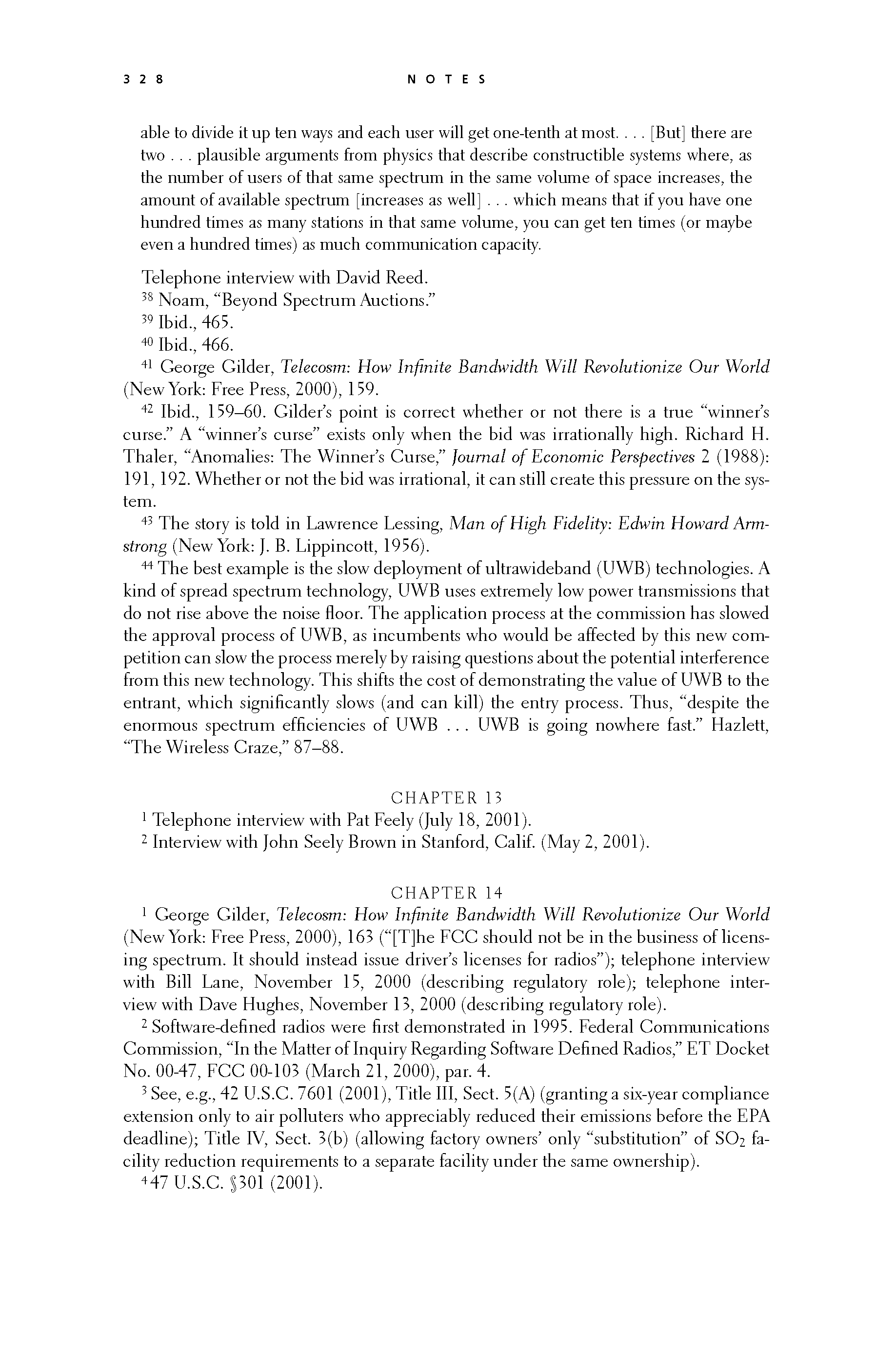 p327 _
-chap- _
toc-1 _
p328w _
toc-2 _
+chap+ _
p329
p327 _
-chap- _
toc-1 _
p328w _
toc-2 _
+chap+ _
p329
____ able to divide it up ten ways and each user will get one-tenth at most... [But] there are
____ two... plausible arguments from physics that describe constructible systems where, as
____ the number of users of that same spectrum in the same volume of space increases, the
____ amount of available spectrum [increases as well]... which means that if you have one
____ hundred times as many stations in that same volume, you can get ten times (or maybe
____ even a hundred times) as much communication capacity.
Telephone interview with David Reed.
[12-38] Noam, "Beyond Spectrum Auctions."
[12-39] Ibid., 465.
[12-40] Ibid., 466.
[12-41] George Gilder, _Telecosm:_How_Infinite_Bandwidth_Will_Revolutionize_Our_World_
(New York: Free Press, 2000), 159.
[12-42] Ibid., 159-160. Gilder's point is correct whether or not there is a true "winner's
curse." A "winner's curse" exists only when the bid was irrationally high. Richard H.
Thaler, "Anomalies: The Winner's Curse," _Journal_of_Economic_Perspectives_ 2 (1988):
191, 192. Whether or not the bid was irrational, it can still create this pressure on the sys-
tem.
[12-43] The story is told in Lawrence Lessing, _Man_of_High_Fidelity:_Edwin_Howard_Arm-_
_strong_ (New York: J. B. Lippincott, 1956).
[12-44] The best example is the slow deployment of ultrawideband (UWB) technologies. A
kind of spread spectrum technology, UWB uses extremely low power transmissions that
do not rise above the noise floor. The application process at the commission has slowed
the approval process of UWB, as incumbents who would be affected by this new com-
petition can slow the process merely by raising questions about the potential interference
from this new technology. This shifts the cost of demonstrating the value of UWB to the
entrant, which significantly slows (and can kill) the entry process. Thus, "despite the
enormous spectrum efficiencies of UWB... UWB is going nowhere fast." Hazlett,
"The Wireless Craze," 87-88.
Chapter 13
[13-1] Telephone interview with Pat Feely (July 18, 2001).
[13-2] Interview with John Seely Brown in Stanford, CA (May 2, 2001).
Chapter 14
[14-1] George Gilder, _Telecosm:_How_Infinite_Bandwidth_Will_Revolutionize_Our_World_
(New York: Free Press, 2000), 163 ("[T]he FCC should not be in the business of licens-
ing spectrum. It should instead issue driver's licenses for radios"); telephone interview
with Bill Lane, November 15, 2000 (describing regulatory role); telephone inter-
view with Dave Hughes, November 13, 2000 (describing regulatory role).
[14-2] Software-defined radios were first demonstrated in 1995. Federal Communications
Commission, "In the Matter of Inquiry Regarding Software Defined Radios," ET Docket
No. 00-47, FCC 00-103 (March 21, 2000), par. 4.
[14-3] See, e.g., 42 U.S.C. 7601 (2001), Title III, Sect. 5(A) (granting a six-year compliance
extension only to air polluters who appreciably reduced their emissions before the EPA
deadline); Title IV, Sect. 3(b) (allowing factory owners' only "substitution" of SO2 fa-
cility reduction requirements to a separate facility under the same ownership).
[14-4] 47 U.S.C. #301 (2001).
[[328]]
p327 _
-chap- _
toc-1 _
p328w _
toc-2 _
+chap+ _
p329